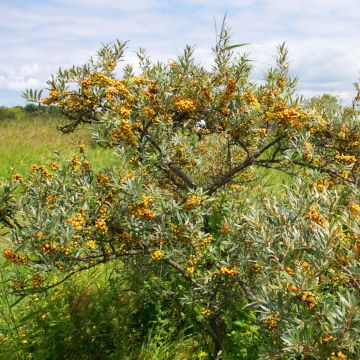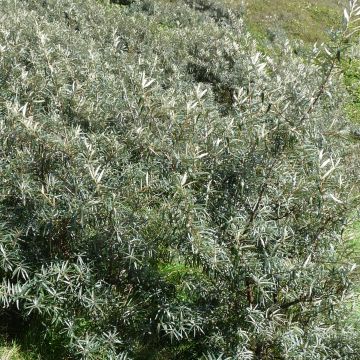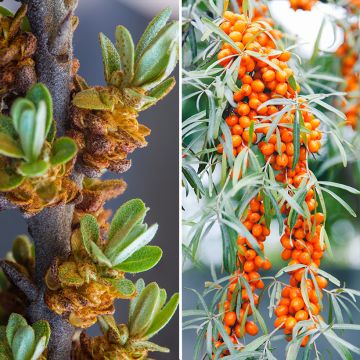

Hippophae rhamnoides Orange Energy Hagebo


Hippophae rhamnoides Orange Energy Hagebo


Hippophae rhamnoides Orange Energy Hagebo


Hippophae rhamnoides Orange Energy Hagebo


Hippophae rhamnoides Orange Energy Hagebo
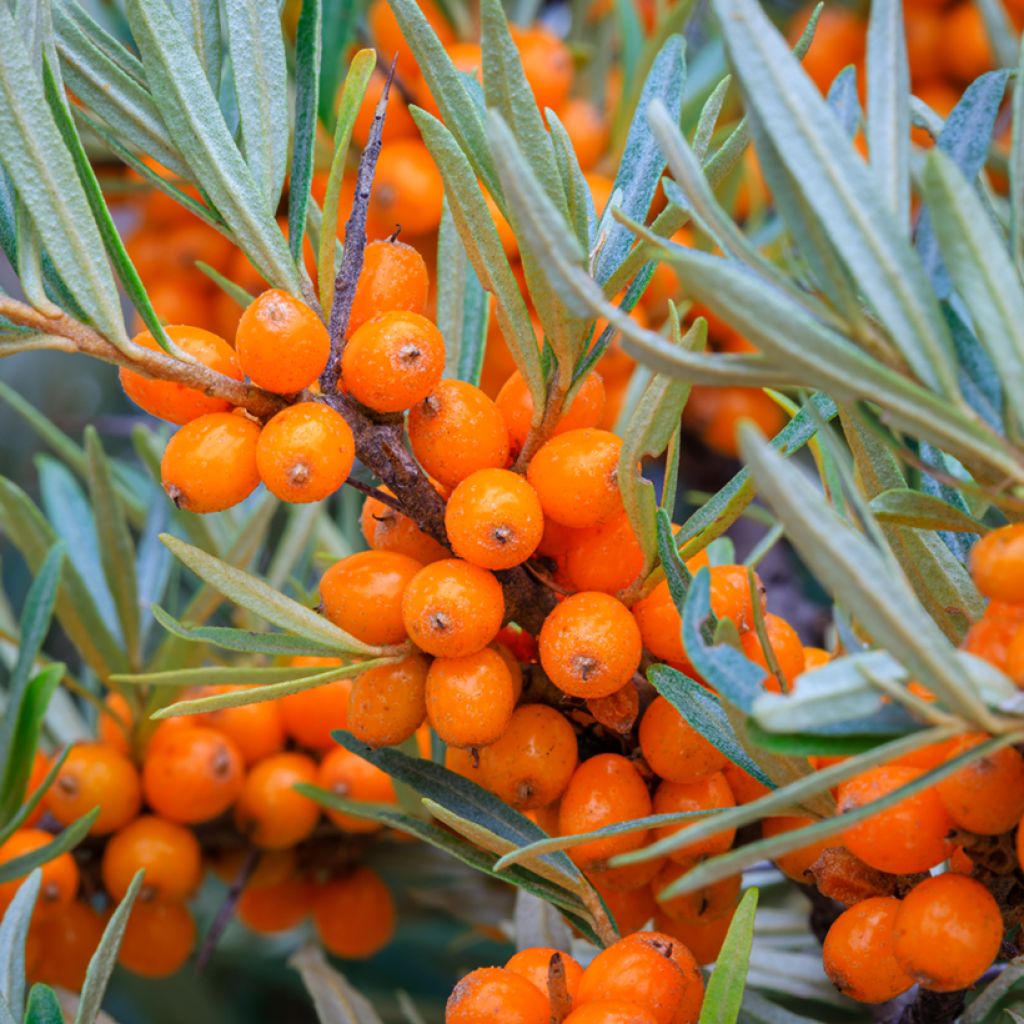

Hippophae rhamnoides Orange Energy Hagebo
Hippophae rhamnoides Orange Energy Hagebo
Hippophae rhamnoides Orange Energy 'Hagebo'
Sea Buckthorn, Sandthorn, Seaberry
This item cannot be shipped to the selected country
Delivery charge from €5.90
More information
Schedule delivery date,
and select date in basket
This plant carries a 24 months recovery warranty
More information
We guarantee the quality of our plants for a full growing cycle, and will replace at our expense any plant that fails to recover under normal climatic and planting conditions.
From €5.90 for pickup delivery and €6.90 for home delivery
Express home delivery from €8.90.
Does this plant fit my garden?
Set up your Plantfit profile →
Description
The Orange Energy 'Hagebo' Sea Buckthorn is a variety that is remarkable for its productivity. From September, the plants are covered with a multitude of large-sized light orange berries. Very decorative, they are also seedless and very rich in vitamin C and can be consumed in jams, jellies, syrups, and even sauces. The Sea Buckthorn is a moderately spiny bush of rapid growth that thrives in ordinary or poor soils. Plant it in a free hedge, a defensive hedge, or as a standalone plant.
The Sea Buckthorn is a member of the small family Elaeagnaceae, whose most well-known representative is undoubtedly the Elaeagnus, and which only has 3 genera in total (the third being Shepherdia). The Hippophae genus itself is also poor in species, with H. rhamnoides being the most widespread under names such as Sea Buckthorn, Siberian Olive, False Buckthorn, and many others depending on the region. It is native to temperate areas of Europe and Asia where it naturally grows as a very spiny bush, reaching up to 5 metres (16 feet 5 inches) in height, or even more. It is a pioneering plant capable of growing both on mountain slopes and in dunes. Although not a Legume, nodules carrying nitrogen-fixing bacteria develop at its roots, allowing it to grow in difficult environments. This allows it to be planted to rehabilitate poor soils and protect them against erosion.
Apart from a few self-fertile varieties, sea buckthorn plants bear either male or female flowers (dioecious plant). Pollination is carried out by insects. Fruiting then requires having a plant of the opposite sex, knowing that a male plant can pollinate five female plants. The berries will then be produced on the female bushes from the 2nd or 3rd year. The Orange Energy variety is a female variety, resulting from a hybridisation programme by the German breeder H.-J. Albrecht in Berlin. It can be pollinated by different male varieties such as Gnom, Pollmix, or Lord. The spring flowers, once fertilised, evolve into light orange berries, of a fairly large size for the species, with an oblong shape. From September until the heart of winter, they cover the bush which can then rival the beauty of any Pyracantha. Very rich in vitamin C (about 30 times more than an orange), the edible berries, quite acidic when raw, are used to make jams, syrups, or sauces that complement meats and fish very well.
Orange Energy has a flexible, fairly wide habit, with branches spreading in all directions, which contributes to its beauty when it is in full fruiting. It can reach 3 metres (9 feet 10 inches) in height if not pruned, with a width of about 2.50 metres, forming a beautiful volume covered with narrow and elongated leaves, about 5-6 cm (2-2.4 in) long and carried by a short petiole. Arranged alternately on the branches, they are of a fairly dark green on the top and grey on the underside. This extremely hardy bush (up to approximately -30°C (-22 °F)) adapts to the majority of soils, even poor and dry ones, and prefers full sun.
Very decorative in winter thanks to its particularly generous fruiting, this Sea Buckthorn can be planted as a standalone plant or in a flower bed, and will be perfect as a lively hedge in a natural garden, accompanied by other bushes with a wild appearance. The Cornelian Cherry (Cornus mas), with its very early yellow flowering and beautiful autumn colours, will also give you edible fruits. Being a source of nectar, it is also a special species useful to bees at a time when flowers are scarce. In the same spirit, the Ballerina Amelanchier will also be a good companion with its magnificent white spring flowering, followed by decorative and edible berries, initially bright red and turning black, not to mention its sumptuous autumn colours of red, orange, and purple.
Report an error about the product description
Hippophae rhamnoides Orange Energy Hagebo in pictures
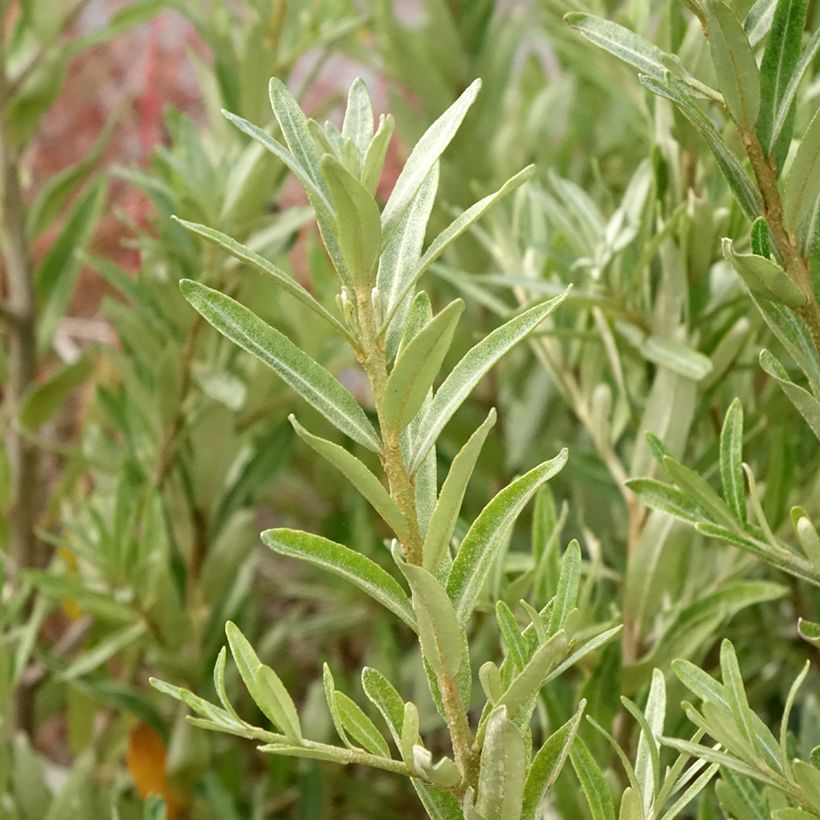

Plant habit
Flowering
Foliage
Botanical data
Hippophae
rhamnoides
Orange Energy 'Hagebo'
Elaeagnaceae
Sea Buckthorn, Sandthorn, Seaberry
Cultivar or hybrid
Other Hippophae
Planting and care
For best results when planting the Orange Energy sea buckthorn, choose a sunny spot or partially shaded area in the south during autumn or spring. The sea buckthorn can grow well in any soil, even poor soil. To plant, soak the root ball in water for 15 minutes and dig a broad, deep hole. Place the top of the root ball level with the ground and fill in with soil. Water the plant during planting. If you plant in autumn and it rains occasionally, additional watering may not be necessary.
The sea buckthorn is a hardy plant that doesn't require special care and is not very susceptible to diseases or pests.
Planting period
Intended location
Care
This item has not been reviewed yet - be the first to leave a review about it.
Hedge shrubs
Haven't found what you were looking for?
Hardiness is the lowest winter temperature a plant can endure without suffering serious damage or even dying. However, hardiness is affected by location (a sheltered area, such as a patio), protection (winter cover) and soil type (hardiness is improved by well-drained soil).

Photo Sharing Terms & Conditions
In order to encourage gardeners to interact and share their experiences, Promesse de fleurs offers various media enabling content to be uploaded onto its Site - in particular via the ‘Photo sharing’ module.
The User agrees to refrain from:
- Posting any content that is illegal, prejudicial, insulting, racist, inciteful to hatred, revisionist, contrary to public decency, that infringes on privacy or on the privacy rights of third parties, in particular the publicity rights of persons and goods, intellectual property rights, or the right to privacy.
- Submitting content on behalf of a third party;
- Impersonate the identity of a third party and/or publish any personal information about a third party;
In general, the User undertakes to refrain from any unethical behaviour.
All Content (in particular text, comments, files, images, photos, videos, creative works, etc.), which may be subject to property or intellectual property rights, image or other private rights, shall remain the property of the User, subject to the limited rights granted by the terms of the licence granted by Promesse de fleurs as stated below. Users are at liberty to publish or not to publish such Content on the Site, notably via the ‘Photo Sharing’ facility, and accept that this Content shall be made public and freely accessible, notably on the Internet.
Users further acknowledge, undertake to have ,and guarantee that they hold all necessary rights and permissions to publish such material on the Site, in particular with regard to the legislation in force pertaining to any privacy, property, intellectual property, image, or contractual rights, or rights of any other nature. By publishing such Content on the Site, Users acknowledge accepting full liability as publishers of the Content within the meaning of the law, and grant Promesse de fleurs, free of charge, an inclusive, worldwide licence for the said Content for the entire duration of its publication, including all reproduction, representation, up/downloading, displaying, performing, transmission, and storage rights.
Users also grant permission for their name to be linked to the Content and accept that this link may not always be made available.
By engaging in posting material, Users consent to their Content becoming automatically accessible on the Internet, in particular on other sites and/or blogs and/or web pages of the Promesse de fleurs site, including in particular social pages and the Promesse de fleurs catalogue.
Users may secure the removal of entrusted content free of charge by issuing a simple request via our contact form.
The flowering period indicated on our website applies to countries and regions located in USDA zone 8 (France, the United Kingdom, Ireland, the Netherlands, etc.)
It will vary according to where you live:
- In zones 9 to 10 (Italy, Spain, Greece, etc.), flowering will occur about 2 to 4 weeks earlier.
- In zones 6 to 7 (Germany, Poland, Slovenia, and lower mountainous regions), flowering will be delayed by 2 to 3 weeks.
- In zone 5 (Central Europe, Scandinavia), blooming will be delayed by 3 to 5 weeks.
In temperate climates, pruning of spring-flowering shrubs (forsythia, spireas, etc.) should be done just after flowering.
Pruning of summer-flowering shrubs (Indian Lilac, Perovskia, etc.) can be done in winter or spring.
In cold regions as well as with frost-sensitive plants, avoid pruning too early when severe frosts may still occur.
The planting period indicated on our website applies to countries and regions located in USDA zone 8 (France, United Kingdom, Ireland, Netherlands).
It will vary according to where you live:
- In Mediterranean zones (Marseille, Madrid, Milan, etc.), autumn and winter are the best planting periods.
- In continental zones (Strasbourg, Munich, Vienna, etc.), delay planting by 2 to 3 weeks in spring and bring it forward by 2 to 4 weeks in autumn.
- In mountainous regions (the Alps, Pyrenees, Carpathians, etc.), it is best to plant in late spring (May-June) or late summer (August-September).
The harvesting period indicated on our website applies to countries and regions in USDA zone 8 (France, England, Ireland, the Netherlands).
In colder areas (Scandinavia, Poland, Austria...) fruit and vegetable harvests are likely to be delayed by 3-4 weeks.
In warmer areas (Italy, Spain, Greece, etc.), harvesting will probably take place earlier, depending on weather conditions.
The sowing periods indicated on our website apply to countries and regions within USDA Zone 8 (France, UK, Ireland, Netherlands).
In colder areas (Scandinavia, Poland, Austria...), delay any outdoor sowing by 3-4 weeks, or sow under glass.
In warmer climes (Italy, Spain, Greece, etc.), bring outdoor sowing forward by a few weeks.



































